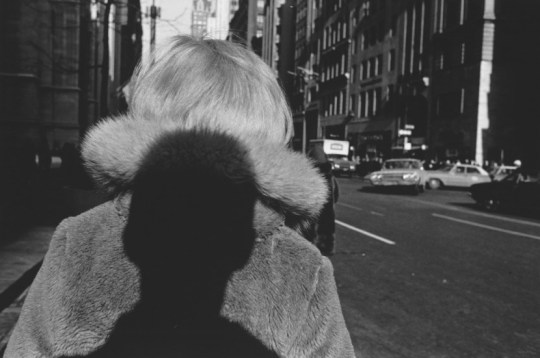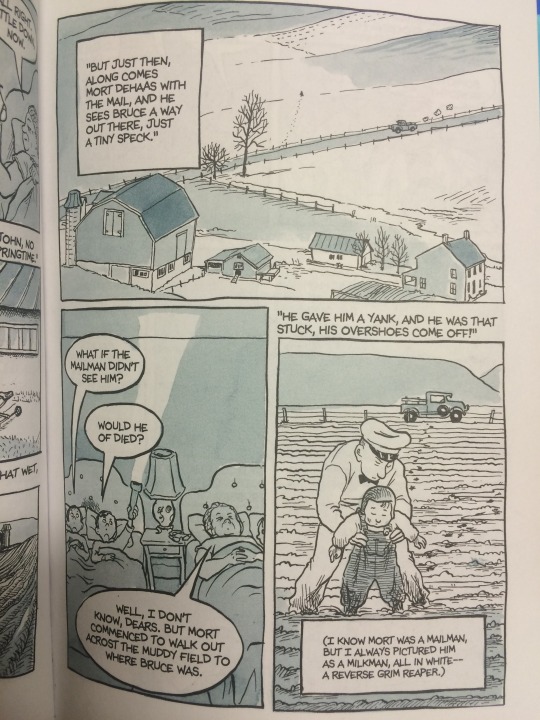Link
This is an interesting article because it is highly sarcastic. The title reads “18 Pictures That Prove This Generation is Absolutely Doomed”. When you first read that many people would immediately think they are talking about our generation, because our generation is said to be social media and texting addicts. But as you read through and look at the multiple pictures of grandparents staring at their phones in social setting you realize they are making fun of how our grandparents are usually the ones telling us to get off out phones, but now they are doing it as well. So, maybe it isn’t our generations, but more so the advancement in technology that is causing people of all generations to be addicted to their phones.
1 note
·
View note
Link
For my show and tell I found this article about Sally Mann’s photography and some of the feedback she has received for her work. This article is interesting to me because after reading about Sally Mann and her personality, I feel like criticism like this doesn't even phase her. She is so independent and creative, and to her she has a vision for her photographs that no one else really see’s apparently. To others these photos of her children are provocative and make her a bad mother, but to her they are pieces of artwork and beautiful images of her children.
1 note
·
View note
Photo

I chose Lee Norman Friedlander for my photographer because his photos are very different to me. His style of photography really intrigued me because his photos immediately made me wonder what exactly is he taking a photo of and what story is this photograph trying to tell?
Lee Friedlander was born on July 14, 1934 in Aberdeen, Washington. He studied photography at the Art Center College of Design in Pasadena, California. He moved to New York City in 1956 where he photographed jazz musicians for record covers. His early work was influenced by Eugène Atget, Robert Frank, and Walker Evans. Working primarily with Leica hand-held 35 mm cameras and back-and-white film, Friedlander’s style focused on the “social landscape”. Friedlander has received many awards for his work and his pieces have also been displayed in many museums including the Museum of Modern Art in New York and San Francisco. In his later life, while suffering from arthritis and housebound, he focused on photographing his surroundings. These photos are different from his earlier work because these photographs are only taken in the confines of his home.
I chose the picture above because it intrigued me and was very different. I found my puncture in the shadow on the man standing behind the woman. I think that man is Lee Friedlander himself taking the photo. This is interesting because many photographers don't incorporate themselves into their work. In fact, one of the “rules” in photography is that you should never have your own reflection or shadow in a photograph. The woman is this photograph is probably just a random person walking down the street. She seems to be wealthy considering she is wearing a fur coat, which also tells us that it is cold outside. Another detail I found in this photograph is the car that is in the middle of the street. To me, it seems like this car shouldn't be there or is driving very recklessly and possibly going to cause a car crash. While all that is going on, this woman is just casually walking down the street and Friedlander is taking a photo of her without her even knowing. This photo tells a story and has so much going on through out it. I am excited to close read and learn more about Lee Friedlander’s work.
4 notes
·
View notes
Quote
As for me, I see both beauty and the dark side of the things; the loveliness of cornfields and full sails, but the ruin as well. And I see them at the same time, at once ecstatic at the beauty of things, and chary of that ecstasy. The Japanese have a phrase for this dual perception: mono no aware. It means "beauty tinged with sadness," for there cannot be any real beauty without the indolic whiff of decay. For me, living is the same thing as dying, and loving is the same thing as losing, and this does not make me a madwoman; I believe it can make me better at living, and better at loving, and, just possibly, better at seeing.
Sally Mann, Hold Still: A Memoir with Photographs
I chose this passage because it strikes me as very powerful and interesting. I’ve observed that Sally Mann was a rebellious teen, she even describes herself as “almost normal”. Throughout this passage Sally goes into detail about what she sees and how she is not a madwoman for believing that very contradicting ideas are, in fact, that same.
Sally uses phrases such as “for me...” and “I believe...” throughout this passage, which shows me that she is not trying to make us believe that this is the correct way to see things or that loving actually is the same thing as losing. She is more so just giving us insight into what goes on in her own mind and how she sees the world everyday. Sally Mann’s tone in this passage sounds very passionate, like this is something she feels deeply about. Her voice is expansive and slightly ornate because she uses some unusual words such as “chary”, “tinged”, “indolic whiff” and because she is also very open about her thoughts and feelings.
I noticed she use many adjectives such as “living”, “dying”, “loving”, and “losing”. Although words like living and dying have opposite meanings she uses them in a way to show similarity instead on difference. She also does this with the words loving and losing. This was slightly hard for me to understand and make me question how she believes that two completely different ideas are the same thing.
In the beginning of the passage Sally states that she see’s both beauty and the dark side of things. I can see why this is true because many of her photographs at first glance seem dark and gloomy, but they also hold beauty. Sally Mann has received some harsh reviews on the nude images of her children by those who fail to see the beauty that she sees in the photographs. I believe that Sally Mann has been very independent and different her whole life and even though she’s been criticized by some, she has not let that change her and has had a very successful career.
2 notes
·
View notes
Photo

For this ekphrastic exercise I chose a photograph taken by the artist Anne W. Brigman in 1915 called “The Shadow on My Door (My Best Self).” This photograph stood out to me because at first glance it is a very terrifying image. An old-fashioned woman creeping out of an old wooden door frame, while the sunlight sneaks through the leaves on a tree in front of her, leaving an odd shadow across her whole face. This photograph is slightly different compared to Anne Brigmans other images. Many of her images are of nude women posing in nature. This photograph differs from her other pieces of art because the woman in this image is not nude, but instead is peeking her head through, what it looks to be, a doorway. My first impression of this photo was that I was going to have nightmares about it. Words like nervous, odd, and horror popped into my head. As I stared at it longer and really tried to analyze the image I noticed that the mysterious woman in this photograph is actually smiling. This helps to explain the title of this piece. To me, this woman could be looking at the reflection of herself and showing confidence because she likes what she sees.
In this image the woman seems to be emerging from the dark space behind her and coming into the light. Although the photograph gives off a negative vibe, I think Brigman was trying to let her readers use their imagination and interpret this photo however they wanted. My punctum in this photo is the woman’s face. You can tell that when Brigman took this photograph she was pretty close to the woman, considering there is not much of a background and because the main focus of this photo is the expression on the woman’s face. I think this photo really allows the viewer to use their imagination and to portray the photograph in various ways.
1 note
·
View note
Link
I found this article that discusses how popular social media sites like instagram are ruining photography and how our appreciation for photographers has disappeared due to the new trend of posting so-called “arsty” photos. I think this has some significance because it is true that photographers and spent years figuring out how to take the perfect photo and now our generation just snaps our camera phones and then calls it photography.
2 notes
·
View notes
Link
I found this article/facebook post and it was really interesting to me because it comes from a photographers point of view and even he is saying that the use of phones and disruptive picture taking has gotten out of control. This article basically talks about how the guests at a wedding ruined some of the professional photos of the ceremony because they were too busy taking photos. It is really worth the read!
0 notes
Link
I found this article that explains the real reasons behind the “selfie”. I found this interesting because our generation has become so obsessed with taking selfies and posting it for their followers so they can see what they’re doing, but what is the real reason why we do all that?
1 note
·
View note
Photo
This is a great analysis! I think that Alison’s father’s death was just a “speed bump” in the road for her because of her posture that seems so carefree, that is also found in many of the pictures throughout the book.

I chose page 41 from Fun Home because right off the bat, I saw significance in not only the words but the pictures as well. Alison writes that her grandma would tell her a story whenever she would spend the night at the “Fun Home”. It was about her father being a child and getting stuck in the mud. I saw not only a lot of significance in the words, but the pictures as well, and even a relation further on in the book. Her dad was exploring and got stuck in the mud. It then flashes to her and her brother as children, and it gets asked if their father would’ve died. I find this evidence of foreshadowing because he had been exploring not only sexually but in other aspects such as his job and then he died. The top picture represents to me not only that Alison’s father was a small child, but that the world is a very big place and at all moments, all you are is a small part in the grand scheme of things. Mort, the mailman came out and helped her father get out of the mud. Alison makes the comment that Mort’s dressed “in all white– a reverse grim reaper”. The grim reaper represents darkness and often death. The reverse of this would be a savior, so she saw Mort as a savior, I believe. This is referenced again in the book on page 52, where her father had already died and was buried. On this page, she said “Stuck in the mud for good this time”, referencing her dad. He had no reverse grim reaper to save him now, for he had already passed on. I believe it’s also symbolic that she’s laying on top of his grave and happens to be the only one there because she looks so relaxed. Her posture shows a type of carefree attitude with her leg crossed over the other. So this poses a question to myself and others: Do you think Alison was really upset over her father’s death or was it just a sort of “speed bump” along the path of life?
20 notes
·
View notes
Text
I chose page 14 for my close reading because not only words stand out to me, but so did the pictures. Alison Bechdel writes “I grew to resent the way my father treated his furniture like children, and his children like furniture” (14). This specific quote caught my attention because as I read the beginning of this book it is clear Alison and her father do not have an ideal relationship. He was more concerned with decorating the house than spending time with his children. Alison also mentions, “And of course, my brothers and I were free labor. Dad considered us extensions of his own body, like precision robot arms” (13). To get a glimpse of what kind of relationship Bechdel had with her dad, I would assume she would be pretty upset at him for giving her a childhood like that, but when Bechdel talks about her father, for example, the first quote I mentioned, she seems so calm and that she didn’t hate him, rather she just “grew to resent him”. I would have expected Bechdel to show more anger when speaking about her dad in this part of the book. This makes me wonder, why is Alison Bechdel so calm when speaking about her father?
1 note
·
View note
Photo

I chose this photograph of Gooseberry Falls that I took this past fall because it reminded me of Sontag’s statement “Photographs furnish evidence. Something we hear about, but doubt, seems proven when we’re shown a photograph of it” (Sontag 5). This photo reminded me of this quote because for me I didn’t know the true beauty of Gooseberry Falls until I saw it for myself and was able to take photos to share with others. This pictures really shows how beautiful nature is. My punctum is in the waterfall and also at the top of the pine trees where they connect with the blue sky. While looking at the photo and thinking back to the moment I took it, I began to think about what Sontag would think of the image. “Needing to have reality confirmed and experience enhanced by photographs is an aesthetic consumerism to which everyone is now addicted” (Sontag 24). To me this quote really relates to the moment I took this picture because instead of enjoying this experience I decided to enhance it by taking a photo. When we do this we forget to truly embrace and experience beautiful moments like this.
1 note
·
View note

